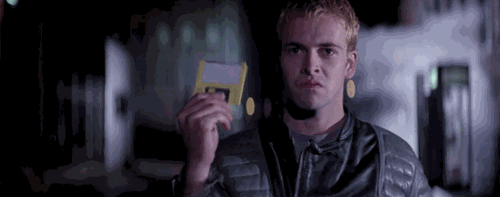Hackers, a '90s Cautionary Tale
Hackers, released in 1995, showcased ridiculous visuals and at times an equally ridiculous portrayal of hackers. It is chalked full of ‘90s cyberpunk flair. If this movie could be summed up in one word, it would have to be camp. At the time Hackers was categorized as science fiction but now a days it seems more science than fiction. While the hairstyles, clothing, and slag might be absurd, some of the hacks are pretty realistic. To see how well this movie holds up, we can go scene by scene to see just how plausible these exploits are today.
Criminally Realistic
At the beginning of the film, we see Dade at eleven years old being convicted of a cybercrime. He created a virus that took out over 1,000 computers. In the ‘80s this number seemed impossible, especially for a kid. His story actually parallels the lives of a couple of real hackers. Kevin Poulsen, notorious for his Porsche hack, was charged when he was only 17 for hacking into multiple universities. Kevin Mitnick was also charged at a young age for hacking into the University of Southern California’s computer database. Like Mitnick, Dade was given a probationary period where he wasn’t allowed to use computers. In this case, he was banned from using computers and touch-tone telephones until he turned 18. This used to be a common consequence for cyber criminals, but the Computer Fraud and Abuse Act of 1986 caused officials to crack down on punishments. Most cybercriminals face time, anywhere from a few months to decades in prison. The longest sentence as of 2024 went to a Russian man who was given 27 years for causing around $169 million in damages through credit card schemes.
Handles and Bleached Hair
The film flashes forward to Dade being 18 and a major cyberpunk. Back on the hacking scene, Dade, otherwise known as Zero Cool or Crash Override, has an elaborate set up for his exploits. He has adorned a bleached buzzcut, a major cyberpunk trend of the 80s. His main form of transportation, roller blades. The costuming and aesthetic of the underground cyber club is cheesy, but it feeds the image that most people had of hackers. Zero cool was Dade's old alias, once his crimes ended up in the news, he changed it to Crash Override for his later exploits. These nicknames are better known as handles, a name chosen by the hacker only for online use. Michael Calce, who is responsible for a series of denial-of-service attacks, one of which took down Yahoo, went by the handle ‘MafiaBoy.’ Gary McKinnon who hacked into military and NASA computers preferred the handle ‘Solo’. All the characters in Hackers have handles. Kate goes by Acid Burn, Ramon’s is Phantom Phreak, even Emmanuel is better known as Cereal Killer online. The use of handles dates back to the 70s when people would use them to explore systems anonymously. In the hacking community, a handle is more than a name, often they represent their owner’s skill level. Crash Override is fitting since Dade is best at crashing systems and then overriding them. Ramon goes by Phantom Phreak because he is an expert at phreaking. Handles are a way for hackers, whether or not they are malicious, to separate their personal life from their life online.
TV Network Hack
The first of the skills we really see from Dade is when he hacks into a TV network, just for fun. Once in, he changed the program to play Outer Limits instead of a news broadcast. Though interrupted as Acid Burn overtook his hack, Dade first got into the system with some social engineering. By calling a security guard and pretending to work for the network, he was able to get the number of a modem and dial into the system that the programming ran from. This part is realistic as it's a common way hackers begin their exploits. The robotic arm jousting match that follows is much more unrealistic. Hacking TV and radio stations still happens today, just in different ways. Sometimes it is through signal hijacking, other times it's through planting malware. Either way, it does not involve a robotic arm fight.
Hacking the School
There are a couple of hacks that Dade does that target his high school. First, he hacks into their administration’s system to put himself in the same class as Kate. We don’t really see how he does this, but for someone with Dade’s abilities, this hack is probably possible. He also breaks into their system to schedule a fire drill that tests the sprinkler system in the school. This seems less probable, but because he already got into the system once, we can assume he could do it again.
Password Security
The film also addresses password security, which is possibly the most accurate and helpful piece if cyber security advice in Hackers. The movie claims that the most common passwords in the world are God, Love, Sex, and Secret. In reality these were common passwords but not the most common. Often in the ‘90s, passwords were simple strings of numbers or names that are personal to the user. This part of Hackers sheds light on a really big problem. Passwords were very easy to crack and even easier to guess. Thankfully today, most people know not to set their password as 1234. Still there are quite a few passwords that are incredibly common and should always be avoided. These include password, admin, strings of consecutive numbers, and abc123.
Revenge is best served with a side of identity theft
To get back at agent Gill, who busted their friend, the two hackers go into competition to see who can mess up his life more. They start with canceling his credit card. Today it's more realistic that a hacker would do this by pulling your information from a website that has your card number. Unfortunately, credit card stealing happens all the time so it's best to make sure you are only putting your information into trusted online retailers. Next, they put a personal ad in a newspaper on Gill’s behalf. This is very easy to do if you just buy the ad space, but this group easily passes through the newspaper’s system to alter an already existing ad. They then give Gill a DUI. This and declaring him dead are harder to believe. Not because these things don’t really happen, they do, but this hack is harder to believe for security reasons.
Computer Fraud and Abuse Act of 1986
The Computer Fraud and Abuse Act of 1986, which Joey is charged under, is a real set of laws that address cyber-based crimes. It is mostly used to address hacking and any form of access without authorization. It has been amended several times since ’86 to address new threats as they develop. Most notably it is the act that Albert Gonzalez and Robert Morris were convicted under. So, Joey’s arrest and conviction are both plausible considering the crimes he was accused of.
Hack the Planet
The biggest hacks take place as the group tries to take down Belford for planting a virus in a garbage file to steal 25 million dollars and cause a major oil spill. Part of this really can happen. Bedford basically uses a worm to steal a percentage of money from each transaction that Ellingson Mineral Company makes. In real life this isn’t normally done using a worm, but it still happens. This technique is best known as ‘salami-slicing'. To cover up this worm, Belford places a program that threatens to capsize an oil tanker. It is considered ransomware because Belford names his price for removing the virus. It is more likely that real hackers would want money in exchange for concealing information on the tanker like location or cargo. There isn’t any good reason a real hacker would threaten to capsize an entire tanker. To take down Bedford the crew dumpster dives for passwords and sends in Laurence as a fake delivery boy to gather password information from the office. Both techniques are still possible today and were done regularly in the past. Data is often discarded without consideration for security. This is why business might require documents to be shredded or put into a separate secured trash bin. The group also wiretapped the company's phones, which is highly illegal but very helpful in their case.
Ultimately to defeat bad guy Bedford the group gathers an army of hackers to clog and distract the company's server so the team can steal information that will clear their names. They basically get hackers from across the world to place as many viruses as possible in the system. Unfortunately, this intense conclusion is the most unrealistic part of the entire movie. Denial-of-service attacks are common, and they sometimes do require real people to overload systems. However, this isn’t done through viruses, that is totally unnecessary and overly complicated. Most denial-of-service attacks are done by overwhelming a server with requests.
All in all, this movie is a whirlwind of bad hair and worse outfits but it brough a decent amount of attention to the existence of hackers. The film also addressed the clear difference between malicious and not malicious hacking. While some hacks are far-fetched and over-the-top, others were pretty accurate. Hackers might not hold up when it comes to critical appeal but it's still a fun watch for cyber nerd everywhere.





